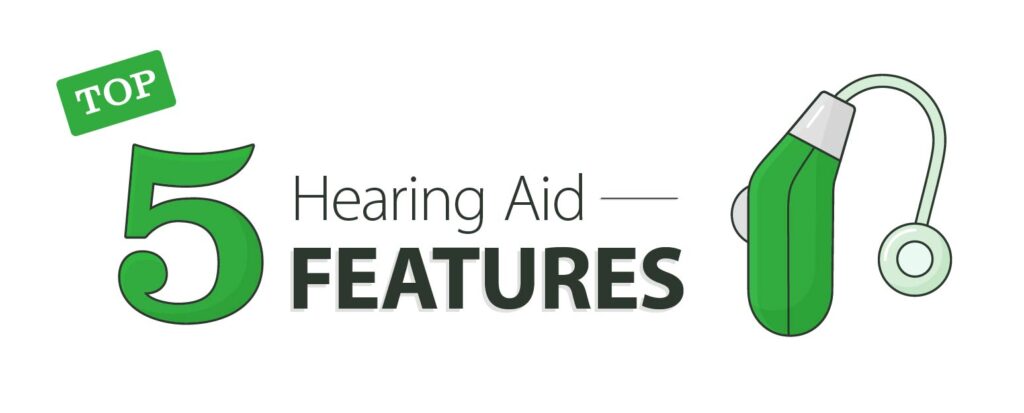If it’s been a few years since your last hearing aid purchase, you may notice a lot has changed. Hearing aid makers are constantly improving hearing technology to create a more natural hearing experience for you.
However, depending on your lifestyle and unique hearing profile, you may or may not need all of these new advanced features, which can affect price as well as function. Below, we’ve listed five of the most popular hearing aid features, how they work, and how they may benefit you. If you understand what these features do and how they affect your life, you can make informed choices when talking to your provider about your next pair of hearing aids.
Channels

The number of channels is usually one of the most prominent features you’ll see listed when looking at hearing aids. If one hearing aid has 4 channels and another one has 6 channels, the latter is probably a better hearing aid, right? Not necessarily. Having more channels doesn’t mean a hearing aid is better or more effective at addressing your unique hearing needs.
How it works:
Hearing aid channels slice the hearing frequency spectrum into many pieces, or “bands,” so a provider can adjust each one individually.
What that means for you:
Some people have more loss in the low end of the spectrum (deep bass sounds like the rumble of a truck engine) and some have loss at the high end (high-pitched sounds like birds tweeting or children’s voices) and some have a mix of the two. Hearing aid channels give the provider a way to “turn up” the volume in different parts of the spectrum without turning up everything. So, if you have a high-end loss, the provider has the option of only turning up the high end of the frequency spectrum, while leaving your low end hearing exactly where it should be and vice versa.
For people with very complex hearing profiles, a high number of channels helps a provider adjust several bands of the frequency spectrum to create a more even and natural hearing experience. If you have a slight loss on one end of the spectrum, you may not need as many channels to have a positive hearing experience.
Directionality

One of the biggest challenges for people with hearing aids is noisy environments, like restaurants, parties, and family get-togethers. Our brains normally help us sort through all the noise and focus on important sounds, like the person we’re having a conversation with. However, hearing aids tend to boost all sounds, which can make it hard to focus on the person in front of you. To combat the confusion extra noise can create, directionality attempts to focus your hearing on the sounds that are primarily in front of you.
How it works:
Directionality uses multiple microphones on your hearing aid to measure the length of time it takes for the same sound to reach each microphone. Then the hearing aid processes the time difference to calculate which direction the sound is coming from. It uses that information to focus on sounds that are directly in front of you while turning down the volume on sounds that are coming from other directions.
What that means for you:
In a noisy environment, hearing aids with directionality will automatically focus their attention on sounds that cut through background noise. Generally, that means focusing on the sound of the person in front of you. There are different levels of directionality, from basic directionality features to advanced and premium adaptive directionality. Highly advanced directionality is best for people who spend a lot of time in noisy places, like conventions, outdoor gatherings, or large meetings.
Noise Reduction and Speech Enhancement

Although directionality focuses on sorting the sounds going on around you, noise reduction and speech enhancement further shape those sounds in order to block out background noise and boost the level of dynamic signals, like speech, so you can hear them better.
How it works:
Noise reduction and speech enhancement take place in a small computer chip in your hearing aid. The chip analyzes all the sounds in the environment and identifies “static” sound signatures, like running water, background chatter, or a dishwasher. These sounds have a constant drone or pitch that doesn’t vary. Then, it identifies “dynamic” sounds, like speech, a TV, or the radio. Dynamic sounds vary greatly in tone and pitch. The hearing aid separates these two types of sound signatures and boosts the dynamic sounds while minimizing the static ones.
What that means for you:
Noise reduction and speech enhancement are standard features on most hearing aids sold today. However, if you frequently find yourself in situations with a lot of background noise, it may be worth investing in hearing aids with advanced or premium noise reduction features.
Feedback Suppression

Anyone with hearing aids can tell you how annoying feedback can be. Feedback occurs when the sound that is piped into your ears is picked up again by the hearing aid microphone, creating a looping sound that turns into a high-pitched whine or whistle. To minimize the annoyance of feedback, hearing aid manufacturers have created systems to identify and stop feedback before it starts.
How it works:
A computer chip in your hearing aid monitors incoming sounds for feedback signals. If a signal is detected, your hearing aid produces an equal and opposite signal to cancel out the feedback within a fraction of a second.
What that means for you:
Feedback suppression is also standard on most hearing aids today. Although feedback will happen from time-to-time with all hearing aids, some people are not as bothered by it as others. If feedback suppression is a major annoyance with your current hearing aids, you may want to ask your provider about hearing aids that have advanced feedback suppression systems.
Wind Suppression

When wind blows across the top of the microphones in your hearing aids, you’ll hear a loud whooshing sound that can be very distracting. Wind suppression systems work to minimize that noise, so you can enjoy outdoor activities without the interruption of loud wind noise.
How it works:
Like noise suppression, wind suppression monitors the sound coming into the hearing aid. When it detects the distinct sound signature of wind blowing across the hearing aid microphones, it automatically turns down the gain to minimize the impact of the sound.
What that means for you:
Wind suppression is a valuable feature for people who spend a lot of time outside. Hiking, sailing, biking, sporting events, and outdoor concerts are much easier to enjoy without the threat of wind noise. If you live a very active, outdoor lifestyle, wind suppression is a feature you should look for in your next hearing aids.
More Questions About Hearing Aid Features?
If you want to know more about hearing aid features, talk to your provider. They can answer your questions and help you determine which hearing aid features fit your needs and lifestyle best.
For answers to other common questions about hearing aids, visit our Ask a Provider page, where you can get in-depth answers from licensed hearing healthcare professionals—and even submit a question of your own!
Learn how TruHearing can help with your hearing health.

